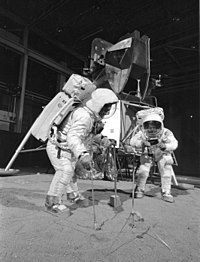
Photo from wikipedia
The internal properties of dark matter haloes correlate with the large-scale halo clustering strength at fixed halo mass – an effect known as assembly bias – and are also strongly… Click to show full abstract
The internal properties of dark matter haloes correlate with the large-scale halo clustering strength at fixed halo mass – an effect known as assembly bias – and are also strongly affected by the local, non-linear cosmic web. Characterizing a halo’s local web environment by its tidal anisotropy α at scales approximately four times the halo radius, we demonstrate that these multiscale correlations represent two distinct statistical links: one between the internal property and α, and the other between α and large-scale (${\gtrsim}30\, h^{-1}\, {\rm Mpc}$) halo bias b1. We focus on scalar internal properties of haloes related to formation time (concentration cvir), shape (mass ellipsoid asphericity c/a), velocity dispersion structure (velocity ellipsoid asphericity cv/av and velocity anisotropy β), and angular momentum (dimensionless spin λ) in the mass range $8\times 10^{11}\lesssim M_{\rm vir}/(\, h^{-1}\, \mathrm{M}_{\odot })\lesssim 5\times 10^{14}$. Using conditional correlation coefficients and other detailed tests, we show that the joint distribution of α, b1, and any of the internal properties c ∈ {β, cv/av, c/a, cvir, λ} is consistent with p(α, b1, c) ≃ p(α)p(b1|α)p(c|α), at all but the largest masses. Thus, the assembly bias trends c↔b1 reflect the two fundamental correlations c↔α and b1↔α. Our results are unaffected by the exclusion of haloes with recent major merger events or splashback objects, although the latter are distinguished by the fact that α does not explain their assembly bias trends. The overarching importance of α provides a new perspective on the nature of assembly bias of distinct haloes, with potential ramifications for incorporating realistic assembly bias effects into mock catalogues of future large-scale structure surveys and for detecting galaxy assembly bias.
Journal Title: Monthly Notices of the Royal Astronomical Society
Year Published: 2019
Link to full text (if available)
Share on Social Media: Sign Up to like & get
recommendations!